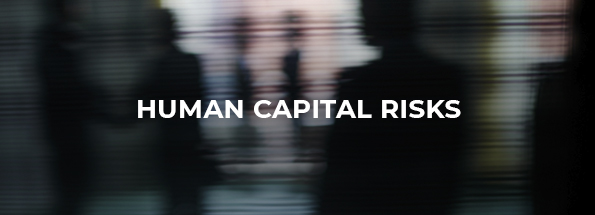5 Startling Facts About Human Capital Risk

People are often referred to as the greatest asset of an organization. While this may be true for your organization, the greater truth is, people also represent an organization’s greatest risks. The actions, inactions, and mere presence or influence of people, present a potential for loss across the spectrum of business activities.
Perhaps no source of risk is more perplexing, hurtful, and damaging than those caused by intentional harmful acts. Consider just a handful of startling facts:
1. 30% of business failures are due to employee theft.
Employee theft costs businesses an estimated $50 billion a year and is rising at a rate of 15 percent per year, according to the U.S. Department of Commerce. The Commerce Department and the American Management Association say that 30 percent of new business failures are due to employee theft and it is believed that 75% of employees steal from their employers at least once. (source)
2. Organizations lose 5% of revenue to ‘fraud from within.’
According to the Association of Certified Fraud Examiners (ACFE), occupational fraud is fraud committed against the organization by its own officers, directors, or employees–an attack against the organization from within, by the very people who were entrusted to protect its assets and resources. In its 2018 Report to the Nations, the ACFE projects that organizations lose 5% of their annual revenue to fraud. Of these cases of fraud, corruption represents one of the most significant fraud risks for organizations, with 70% of such cases perpetrated by someone in a position of authority (managers and owner/executives).
3. Workplace violence is the fastest-growing category of murder in the U.S.
According to OSHA, every year, 2 million American workers report having been victims of workplace violence. The Center for Applied Learning reports that workplace violence incidents have tripled in the last decade and is now the fastest-growing category of murder in the United States. And according to the Bureau of Labor Statistics (2016), fatal work injuries involving violence and other injuries by persons or animals increased by 163 cases to 866 in 2016; workplace homicides increased by 83 cases to 500 in 2016; and workplace suicides increased by 62 to 291. This is the highest homicide figure since 2010 and the most suicides since data collection began in 1992.
4. One in five American adults have experienced sexual harassment at work.
A CNBC survey found one-fifth of American adults have experienced sexual harassment at work. By age group, 16 percent of those ages 18 to 34 said they have been victims, while 25 percent of 50- to 64-year-olds say they have been. What’s more, according to a 2003 EEOC study, 75 percent of employees who spoke out against workplace mistreatment faced some form of retaliation.
5. 80% of active shooter incidents occur in the workplace.
The Center for Applied Learning reports active shooter incidents tripled in the last eight years, with an event occurring in the U.S. once every three weeks; furthermore, workers are now 18 times more likely to encounter workplace violence and an active shooter situation than a fire. According to FBI statistics, of 160 active shooter incidents in the United States between 2000 and 2013, over 80 percent (132) occurred at work.
Where there are people, there are risks. The actions taken by employees and even subcontractors representing your organization have a direct impact on the productivity, safety, and success of your organization. When those actions turn bad, either through negligence or intentional acts, the damage to people, brands, and profits can be significant. What are you doing to identify, prepare for, and mitigate your human capital risks?

 An employer is exposed to risk caused by the conduct of an employee whether or not such conduct is within the course and scope of the employee’s employment. Focusing your organization’s human capital risk mitigation measures on only one of these areas of potential exposure may be hazardous to the financial and reputational health of your organization.
An employer is exposed to risk caused by the conduct of an employee whether or not such conduct is within the course and scope of the employee’s employment. Focusing your organization’s human capital risk mitigation measures on only one of these areas of potential exposure may be hazardous to the financial and reputational health of your organization.
 Uncertainty is and always has been the issue of contention for risk managers. But the degree and range of global uncertainty faced by organizations around the world is truly unprecedented. Events that have occurred since the 2001 terrorist attacks point to levels and areas of risk many had never before imagined. Natural disasters, acts of terror, corporate governance scandals, the dot-com collapse, the housing bubble burst—events like these and the uncertainty they have injected into the world have caused organizations to place a greater and broader emphasis on risk management.
Uncertainty is and always has been the issue of contention for risk managers. But the degree and range of global uncertainty faced by organizations around the world is truly unprecedented. Events that have occurred since the 2001 terrorist attacks point to levels and areas of risk many had never before imagined. Natural disasters, acts of terror, corporate governance scandals, the dot-com collapse, the housing bubble burst—events like these and the uncertainty they have injected into the world have caused organizations to place a greater and broader emphasis on risk management.
 Emerging risks—both new risks and familiar risks in unfamiliar conditions—have taken on new meaning and importance in today’s increasingly
Emerging risks—both new risks and familiar risks in unfamiliar conditions—have taken on new meaning and importance in today’s increasingly 